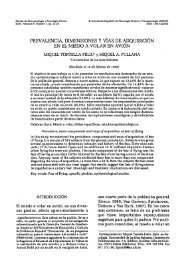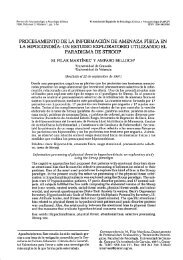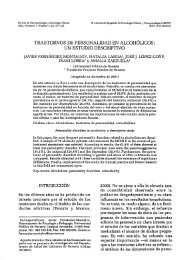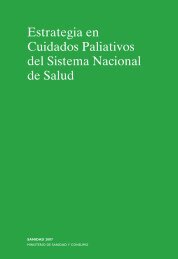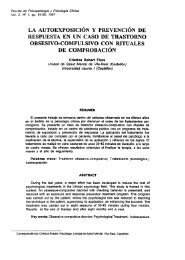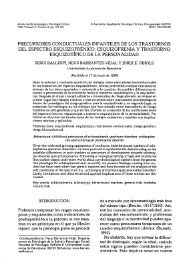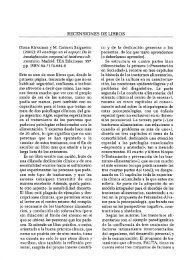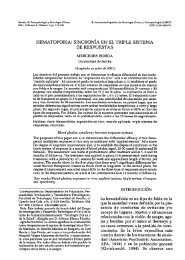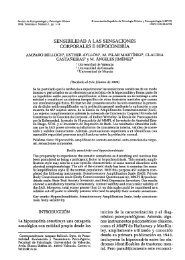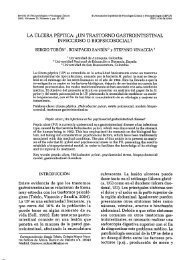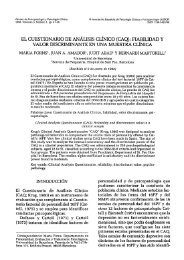Pensamientos Intrusos en Obsesivos SubclÃnicos ... - e-spacio UNED
Pensamientos Intrusos en Obsesivos SubclÃnicos ... - e-spacio UNED
Pensamientos Intrusos en Obsesivos SubclÃnicos ... - e-spacio UNED
Create successful ePaper yourself
Turn your PDF publications into a flip-book with our unique Google optimized e-Paper software.
<strong>P<strong>en</strong>sami<strong>en</strong>tos</strong> intrusos <strong>en</strong> obsesivos subclínicos 35<br />
Freeston, M.H., Ladouceur, R, Thibodeau, N.<br />
y Gagnon, F. (1991). Cognitive intrusions<br />
in a non-clinical population I. Response<br />
style, subjective experi<strong>en</strong>ce, and appraisal.<br />
Behaviour Research and Tberapy, 29, 585-<br />
597.<br />
Freeston, M., Ladouceur, R., Gagnon, F. y Thibodeau,<br />
N. (1993). Beliefs about obsessional<br />
thoughts. Journal of Psychopathology<br />
and Behavioral Assesm<strong>en</strong>t, 15, 1-21.<br />
Freeston, M., Ladouceur, R., Prov<strong>en</strong>cher, M.<br />
y Blais, F. (1995). Strategies used with<br />
intrusive thoughts: context, appraisal,<br />
mood and efficacy. Journal of Anxiety<br />
Disorders, 9, 201-215.<br />
Frost, R.O., Lahart, C.M., Dugas, K.M. y Sher,<br />
K.J. (1988). Information among non-clinical<br />
compulsives. Behaviour Research and<br />
Therapy, 26, 275-277<br />
Frost, R.O., Sher, K.J. y Gre<strong>en</strong>, T. (1986). Psychopathology<br />
and personality characteristics<br />
of non-clinical compulsive checkers.<br />
Behaviour Research and Therapy, 24, 135-<br />
143.<br />
Frost, R.O., Steketee, G., Cohn, L. y Griess, K.<br />
(1994). Personality traits in subclinical and<br />
nonobsessive-compulsive volunteers and<br />
their par<strong>en</strong>ts. Behaviour Research and Therapy,<br />
32, 47-56.<br />
Gibbs, N.A. (1996).Nonclinical populations<br />
in research on obsessive-compulsive disorder:<br />
a critical review. Clinical Psychology<br />
Review, 16, 729-773.<br />
Gibbs, N.A. y Oltmanns, T.F.(1995). The relation<br />
betwe<strong>en</strong> obsessive-compulsive personality<br />
traits and subtypes of compulsive<br />
behavior. Journal of Anxiety Disorders, 5,<br />
397-410.<br />
Goodwrin, A.H. y Sher, K.J. (1992). Déficits in<br />
set-shifting ability in nonclinical compulsive<br />
checkers. Journal of Psychopathology<br />
and Behavioral Assessm<strong>en</strong>t, 14, 81-91.<br />
Hodgson, R.J. & Rachman, S. (1977). Obsessive-compulsive<br />
complaints. Behaviour<br />
Research and Therapy, 15, 389-395.<br />
Lucero,M. [2002). <strong>P<strong>en</strong>sami<strong>en</strong>tos</strong> intrusivos <strong>en</strong><br />
población g<strong>en</strong>eral. Tesis Doctoral. Facultad<br />
de Psicología. Universitat de Val<strong>en</strong>cia.<br />
Lucero.M., Morillo, C., Cabedo, E., Garrió, C.,<br />
y Belloch,A. (2001). Difer<strong>en</strong>cias transculturales<br />
<strong>en</strong> p<strong>en</strong>sami<strong>en</strong>tos intrusos análogos<br />
a las obsesiones. Actas del III Congreso de<br />
la Asociación Española de Psicología Clínica<br />
y Psicopatología (AEPCP).Val<strong>en</strong>cia:<br />
Promolibro.<br />
Morillo, C., Lucero, M., Garrió, C., Gabedo, E.<br />
y Belloch, A. (2001). Validación de un<br />
cuestionario que mide p<strong>en</strong>sami<strong>en</strong>tos intrusos<br />
análogos a las obsesiones. Actas del III<br />
Congreso de la Asociación Española de<br />
Psicología Clínica y Psicopatología<br />
(AEPCP). Val<strong>en</strong>cia: Promolibro.<br />
Niler, E.R. y Beck, S.J. (1989). The relationship<br />
among guilt, anxiety and obsessions in<br />
a normal population. Behaviour Research<br />
and Therapy, 27, 213-220.<br />
Obsessive Compulsive Gognitions Working<br />
Group (1997). Gognitive assessm<strong>en</strong>t of<br />
obsessive-compulsive disorder. Behaviour<br />
Research and Therapy, 35, 667-681.<br />
Obsessive Gompulsive Gognitions Working<br />
Group. (2001). Developm<strong>en</strong>t and initial<br />
validation of the obsessive beliefs questionnaire<br />
and the interpretation of intrusions<br />
inv<strong>en</strong>tory. Behaviour Research and<br />
Therapy, 39, 987-1006.<br />
Parkinson, L. y Rachman, S. (1981). Part IL<br />
The nature of intrusive thoughts. Advances<br />
in Behaviour Research and Therapy, 3,<br />
101-110.<br />
Purdon, G. y Glark, D.A. (1993). Obsessive<br />
Intrusive Thoughts in nonclinical subjects.<br />
Part I. Gont<strong>en</strong>t and relation with depressive,<br />
anxious and obsessional symptoms. Behaviour<br />
Research and Therapy, 31, 713-720.<br />
Purdon, G. y Glark, D.A. (1994a). Obsessive<br />
intrusive thoughts in nonclinical subjects.<br />
Part II. Gognitive appraisal, emotional response<br />
and thought control strategies. Behaviour<br />
Research and Therapy, 32, 403-410.<br />
Purdon, G. y Glark, D.A. (1994b). Perceived<br />
control and appraisal of obsessional intrussive<br />
thoughts: A replication and ext<strong>en</strong>sión.<br />
Cognitive-Behavioural Psychotherapy, 22,<br />
269-285.<br />
Purdon, G. y Glark, D.A. (1999). Metacognition<br />
and obsessions. Clinical Psychology<br />
and Psychotherapy, 6, 102-110.<br />
Rachman, S. (1997). A cognitive theory of<br />
obsessions. Behaviour Research and Therapy,<br />
35, 793-802.<br />
Rachman, S. (1998). A cognitive theory of<br />
obsessions: Elaborations. Behaviour Research<br />
and Therapy, 36, 385-401.



